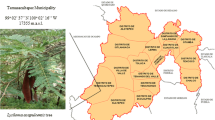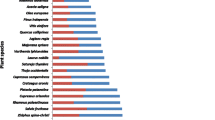Abstract
Gastrointestinal nematodes remain a major constraint on the health, welfare, and production of small ruminants. This study was conducted to evaluate three plant extracts (from Bridelia ferruginea, Combretum glutinosum, and Mitragyna inermis) as effective remedies against gastrointestinal parasites of small ruminants. Phytochemical screening was conducted on the plant leaves, and the potential anthelmintic properties of these plants were tested in vitro on Haemonchus contortus using the egg hatch, larval migration, and adult worm motility assays. The phytochemical screening of the leaves revealed the presence of several bioactive components in all the plants. The number of eggs that hatched was reduced in a concentration-dependent manner (p < 0.01) upon treatment with the methanol extract of B. ferruginea and the acetone extracts of C. glutinosum and M. inermis. The inhibitory effect of the acetone extract of B. ferruginea and the methanol extracts of C. glutinosum and M. inermis was not concentration-dependent (p > 0.05). There was a significant difference (p < 0.05) in the reduction in larval migration between the lowest concentrations (75 to 150 μg/mL) and the highest concentrations (300 to 1200 μg/mL) of plant extracts. The ability of plant extracts to affect the mobility of the adult worms was not concentration-dependent (p > 0.05); however, it was dependent on the time of incubation (p < 0.01). At the highest concentration (2400 μg/mL), all adult worms were motionless after 24 h of exposure, while at the lowest concentration (< 150 μg/mL), this occurred after 48 h of exposure. M. inermis and C. glutinosum extracts were more effective than B. ferruginea extracts (p < 0.05). Overall, these results suggest that these plants used by small-scale farmers possess antiparasitic properties useful for helminthiasis control. However, the effects of the plants remain to be confirmed via in vivo assays and toxicity tests in further studies.


Similar content being viewed by others
References
Adamu M, Naidoo V, Eloff JN (2013) Efficacy and toxicity of thirteen plant leaf acetone extracts used in ethnoveterinary medicine in South Africa on egg hatching and larval development of Haemonchus contortus. BMC Vet Res 9:38. https://doi.org/10.1186/1746-6148-9-38
Ademola IO, Fagbemi BO, Idowu SO (2005) Anthelmintic activity of extracts of Spondias mombin against gastrointestinal nematodes of sheep: studies in vitro and in vivo. Trop Anim Health Prod 37(3):223–235
Alissou B (2013) Usages, disponibilité et caractéristiques dendrométriques des ligneux médicinaux: Bridelia ferruginea Benth, Combretum glutinosum Perr. et Mitragyna inermis (Willd.) O. Ktze dans les zones agro-climatiques du Bénin. Mémoire de master professionnel en agronomie: Faculté des Sciences Agronomiques, Université d’Abomey-Calavi, pp 87
Alowanou GG, Olounladé AP, Azando EVB, Dédéhou VFGN, Daga FD, Hounzangbé-Adoté SM (2015) A review of Bridelia ferruginea, Combretum glutinosum and Mitragyna inermis plants used in zootherapeutic remedies in West Africa: historical origins, current uses and implications for conservation. J Appl Biosci 87:8003–8014
Attindéhou S, Houngnimassoun MA, Salifou S, Biaou CF (2012) Inventorying of herbal remedies used to control small ruminant’s parasites in Southern Benin. Int Multidiscip Res J 2:14–16
Azando EVB, Hounzangbé-Adoté MS, Olounladé PA, Brunet S, Fabre N, Valentin A (2011) Involvement of tannins and flavonoids in the in vitro effects of Newbouldia laevis and Zanthoxylum zanthoxyloïdes extracts on the exsheathment of third-stage infective larvae of gastrointestinal nematodes. Vet Parasitol 180:292–297
Coles GC, Bauer C, Borgsteede FHM, Greerts S, Klei TR, Taylor MA (1992) World association for the advancement of veterinary parasitology (WAAVP) methods for the detection of anthelmintic resistance in nematodes of veterinary importance. Vet Parasitol 44:35–44
D’Assonville JA, Janovsky E, Versley A (1996) In vitro screening of Haemonchus contortus third stage larvae for ivermectin resistance. Vet Parasitol 61:73–80
Dédéhou VFGN, Olounladé PA, Adenilé AD, Azando EVB, Alowanou GG, Daga FD, Hounzangbé-Adoté MS (2014) Effets in vitro des feuilles de Pterocarpus erinaceus et des cosses de fruits de Parkia biglobosa sur deux stades du cycle de développement de Haemonchus contortus nématode parasite gastro-intestinal de petits ruminants. J Anim Plant Sci 22:3368–3378
Diehl MS, Atindehou KK, Téré H, Betscharta B (2004) Prospect for anthelminthic plants in the Ivory Coast using ethnobotanical criteria. J Ethnopharmacol 2(3):277–284
Djoueché CM, Azebaze AB, Dongmo AB (2011) Investigation of plants used for the ethnoveterinary control of gastrointestinal parasites in Bénoué region, Cameroon. Tropicultura 29:205–211
Eloff JN (1998) Which extractant should be used for the screening and isolation of antimicrobial components from plants? J Ethnopharmacol 60:1–8
Hammond JA, Fielding D, Bishop SC (1997) Prospects for anthelmintic plants in tropical veterinary medicine. Vet Res Commun 21:213–228
Hoste H, Jackson F, Athanasiadou S, Thamsborg S, Hoskin SO (2006) The effects of tannin-rich plants on parasitic nematodes in ruminants. Trends Parasitol 22:253–261
Houghton PJ, Raman A (1998) Laboratory handbook for the fractionation of natural extracts, 1st edn. Ed Chapman and Hall, New York, p 199
Hounzangbé-Adoté MS, Paolini V, Fouraste I, Moutairou K, Hoste H (2005) In vitro effects of four tropical plants on three life-cycle stages of the parasitic nematode, Haemonchus contortus. Res Vet Sci 78:155–160
Kaboré A, Tamboura H, Belem AMG, Traoré A (2007) Traitements ethno-vétérinaires des parasitoses digestives des petits ruminants dans le plateau central du Burkina Faso. Int J Biol Chem Sci 1:297–304
Koné WM, Atindehou KK (2007) Ethnobotanical inventory of medicinal plants used in traditional veterinary medicine in Northern Côte d’Ivoire (West Africa). S Afr J Bot 74:76–8416
Koné WM, Atindehou KK, Dossahoua T, Betschart B (2005) Anthelmintic activity of medicinal plants used in Northern Côte d’Ivoire against intestinal helminthiasis. Pharm Biol 43(1):72–78. https://doi.org/10.1080/13880200590903408
Lasisi AA, Kareem SO (2011) Evaluation of anthelmintic activity of the stem bark extract and chemical constituents of Bridelia ferruginae (Benth) Euphorbiaceae. Afr J Plant Sci 5(8): 469–474
MAEP (2011) Plan stratégique de relance du secteur agricole (PSRSA), Cotonou, République du Bénin, Octobre 2011, pp 112. http://extwprlegs1.fao.org/docs/pdf/ben149176.pdf
Makkar HPS, Sidhuraju P, Becker K (2007) Plant secondary metabolites. In: 1st. Humana Press Inc, New Jersey
Maphosa V, Masika PJ, Bizimenyera ES, Eloff JN (2010) In vitro anthelminthic activity of crude aqueous extracts of Aloe ferox, Leonotis leonurus and Elephantorrhiza elephantina against Haemonchus contortus. Trop Anim Health Prod 42:301–307
Mengistu G, Hoste H, Karonen M, Salminen J-P, Hendriks WH, Pellikaan WF (2017) The in vitroanthelmintic properties of browse species against Haemonchus contortus is determined by the polyphenol content and composition. Vet Parasitol 237:110–116
Mini KP, Venkateswaran KV, Gomathinayagam S, Selvasubramanian S, Bijargi SR (2013) In vitro anthelmintic effect of aqueous and ethanol extract of Aristolochia indica against Haemonchus contortus. JPPA 3:148–158
Neal MJ (2002) Medical pharmacology at a glance, 1st edn. Blackwell Science, Oxford
R Core Team (2013) A language and environment for statistical computing: R Foundation for Statistical Computing, Vienna, Austria. http://www.R-project.org/. Accessed 24 Feb 2017
Rabel B, McGregor P, Dough G (1994) Improved bioassay for estimation of effects of ovine gastrointestinal inhibitoty mucus and on nematode larval migration anthelminthic. Int J Parasitol 24:671–676
Salifou S (1996) Nématodes et nématodose du tube digestif des petits ruminants du Sud Bénin : Taxonomie, Epidémiologie et les facteurs de variation. Thèse de doctorat, Université Cheikh Anta Diop de Dakar, Sénégal, pp 162
Sibanda BJS, Dube AB (2014) Beef cattle development initiatives: a case of Matobo A2 Resettlement farms in Zimbabwe. Glob J Anim Sci Res 2(3):197–204
Stein PA, Georges SD, Rolfe PF, Hosking BC (2011) Safety and efficacy against fourth-stage gastrointestinal nematode larvae, of monepantel in 6-week old lambs. Vet Parasitol 185(2–4):339–342
Venables WN, Ripley BD (2002) Modern applied statistics with S, 4th edn. Springer, New York ISBN 0 - 387-95457-0
Wabo-Poné J, Yondo J, Fossi TO, Komtangi MC, Bilong-Bilong CF, Mpoame M (2011) The in vitro effects of Chenopodium ambrosioides (Chenopodiaceae) extracts on the parasitic nematode Heligmosomoides bakeri (Nematoda, Heligmosomatidae). J Pharmacogn Phytother 3:56–62
Zangueu CB, Olounlade AP, Ossokomack M, Djouatsa YNN, Alowanou GG, Azebaze AGB, Llorent-Martínez EJ, Fernández de Córdova ML, Dongmo AB, Hounzangbe-Adote MS (2018) In vitro effects of aqueous extract from Maytenus senegalensis (Lam.) Exell stem bark on egg hatching, larval migration and adult worms of Haemonchus contortus. BMC Vet Res 14:147–158
Acknowledgements
This work was supported mainly by the INTERNATIONAL FOUNDATION FOR SCIENCE (IFS) and the Competitive Research Fund of the University of Abomey-Calavi. This study would not have been completed without the traditional healers and small-scale farmers of Benin and the staff of the Laboratory of Ethnopharmacology and Animal Health, FSA, UAC.
Author information
Authors and Affiliations
Corresponding author
Ethics declarations
Ethics approval and consent to participate
The present study was approved and conducted in accordance with the guidelines of the Ethical Committee of University of Abomey – Calavi (EC approval 2015/1134), and after receiving approval, all experiments were conducted using the guidelines of the World Association for the Advancement of Veterinary Parasitology (WAAVP). In addition, it is important to note that consent was obtained from all participants, especially from the animal owners of South and North Benin, who usually use the three plants to treat their animals against parasites of the ruminant gastrointestinal tract.
Consent to publish
Not applicable.
Conflict of interest
The authors declare that they have no conflict of interest.
Additional information
Section Editor: Ramaswamy Kalyanasundaram
Publisher’s note
Springer Nature remains neutral with regard to jurisdictional claims in published maps and institutional affiliations.
Rights and permissions
About this article
Cite this article
Alowanou, G.G., Olounladé, P.A., Akouèdegni, G.C. et al. In vitro anthelmintic effects of Bridelia ferruginea, Combretum glutinosum, and Mitragyna inermis leaf extracts on Haemonchus contortus, an abomasal nematode of small ruminants. Parasitol Res 118, 1215–1223 (2019). https://doi.org/10.1007/s00436-019-06262-5
Received:
Accepted:
Published:
Issue Date:
DOI: https://doi.org/10.1007/s00436-019-06262-5




